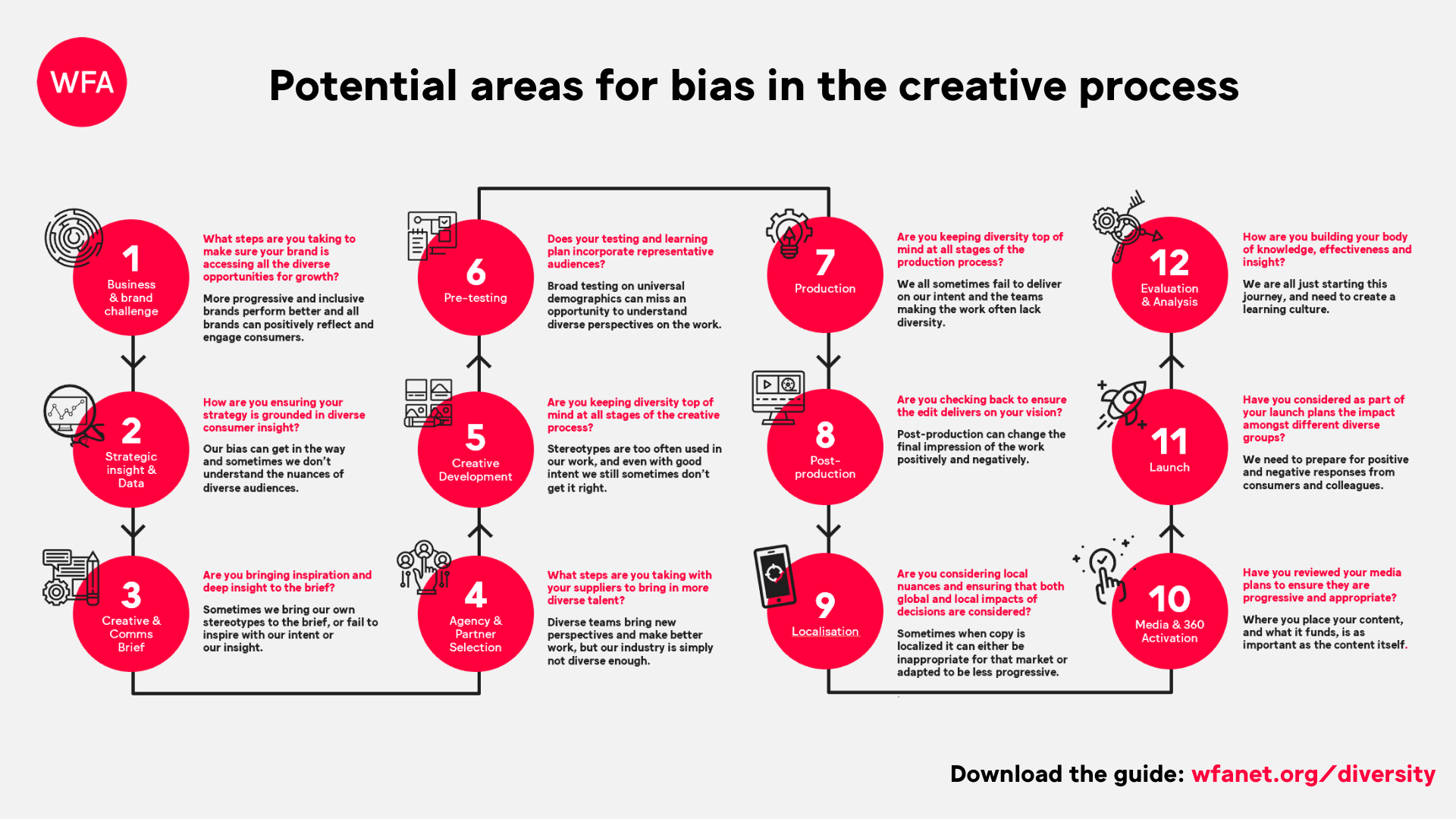Get analysis, insight & opinions from the world's top marketers.
Sign up to our newsletter.
Comprehensive framework details potential issues at every stage of the creative process

WFA has launched the world’s first-ever open-source guide to tackling diversity and representation issues throughout the entire creative process, from defining the business and brand challenges to evaluation and analysis.
Diversity & Representation: A Guide to Potential Areas for Bias in the Creative Process highlights 12 key areas where bias can occur and proposes questions that can be used as a litmus test at every stage. It also pulls together some key resources that can be used to tackle any gaps or areas of concern.
Every stage of the process, from creative briefing to insight and localisation to media placement, is illustrated with brand examples and the guide includes campaigns from WFA members such as AB InBev, Diageo, GSK, IKEA, Mars, Mattel, P&G, Philips and Unilever.
The new document has been co-developed by members of WFA’s Diversity & Inclusion Task Force, which launched last year, and which is led by the WFA’s diversity ambassadors Jerry Daykin, GSK Senior Media Director, and Belinda Smith, CEO Americas at m/SIX.
The document will be freely available to everyone in the industry as part of WFA’s ongoing commitment to boosting diversity and inclusion and improving representation globally, and can be downloaded from WFA’s Diversity & Inclusion Hub.
Jerry Daykin, who led this initiative as part of the taskforce group on ‘representation in marketing’, said the onus was on marketers to be part of society’s journey in tackling diversity gaps.
“Many companies trying to drive this change don’t know where to start, and often the barriers to representative creative come in the form of unconscious bias. This guide aims to highlight some of the simple nudges and critical questions marketers can use to avoid the gaps in representation that these biases can create,” he said. “We can all go on a journey from not considering diverse audiences to fairly representing them, or even purposefully driving action for change. It’s been a great experience to input our GSK best practice into this guide, but also to learn from other task force members.”
Diversity & Representation: A Guide to Potential Areas for Bias in the Creative Process is the first publication from the WFA Diversity Task Force, which brings together stakeholders from brands, creative and media agencies, industry bodies and the UN Women-led Unstereotype Alliance.
The group’s work is guided by four key goals as it aims to become the:
“The aim of all we are doing on the taskforce is to keep the industry accountable to their stated DEI intentions and making tangible, demonstrative progress. We always hear marketers asking for examples or specific tactics they can use to create systemic and holistic change and this guide is an important and powerful illustration of how we can completely rethink or interrupt a process to ensure we’re living up to our goals and making our industry better with each piece of work,” said Belinda Smith, WFA Global Diversity Ambassador and Americas CEO, m/SIX.
“Increasingly, brands have to be nimble and agile. Working at speed can mean cutting corners in the creative process. This is when mistakes can happen and the resultant creative can fail to represent society in all its diversity. We hope this new framework will provide brands and their agencies with practical guidance that helps them avoid such pitfalls and ensure that content is as representative and inclusive as possible,” said Camelia Cristache, WFA Senior Communications Manager and WFA Diversity & Inclusion Lead.
Gráinne Wafer, Global Brand Director for Guinness at Diageo: “At Diageo, we really believe that only through working together, can we create the urgency and scale of change that is required to make our marketing industry more progressive & diverse. In contributing to this guide we shared our experience, and some practical examples of how to support a range of voices, celebrate diversity and achieve more progressive marketing. By collaborating, we learned so much from the experiences of other organisations in the taskforce on where we can make greater strides on this vital agenda, and help create industry wide change.”
Dale Green, Global Brand Director, Mars: “At Mars we believe the world we want tomorrow starts with how we do business today. As a leading global advertiser, we have a responsibility to make sure our brands speak to and celebrate the diversity of the audiences who enjoy them.”
Anne Joffre-Bonnaillie, Senior Director, E&I in Advertising, Procter & Gamble: “At P&G we are committed to leveraging our brands’ voices around globe to shape a more equal world through advertising. Our efforts are on track to deliver 100% positive and accurate representation on screen and hire 50% female directors behind the camera to shoot our commercials. Since our Chief Brand Officer, Marc Pritchard, initiated this journey at Cannes Lions in 2017, we have learned that E&I change happens through organization’s accountability, capability building, and clear KPIs. The new WFA guide does an amazing job in the last two areas, driving awareness of the opportunities and pitfalls in representation, as well as calling out highly relevant resources and partners for talent or measurement at every stage of the creative and production process. A must have for every marketer!”
Sara Denby, Head of the Unstereotype Alliance Secretariat, UN Women: “Nobody is immune to unconscious bias. The Creative Development Bias Map serves as a vital reminder to search for the stereotypes we might not readily see and consistently challenge our own implicit biases. If we combine this with the tools that promote progressive depictions of all people, we have a potent framework to create advertising that is truly free from destructive stereotypes - something we urgently need to accelerate.”